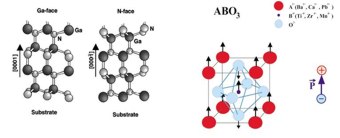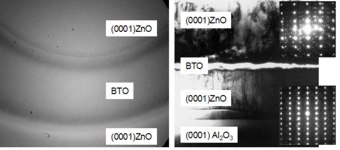Research goals
Coupling between the spontaneous polarization in wurtzite structures and the ferroelectric
polarization in perovskite structures is the subject of this research field. Of particular interest is whether
the ferroelectric phase transition can be influenced by the spontaneous electric polarization in perovskite-wurtzite
heterostructures. The concept is to bring bound ionic charges at the interface of wurtzite structure materials
in contact with switchable ionic charges at the interface of ferroelectric perovskite materials. The amount of the
charge can be varied by the thickness of adjacent layers. If the polarization axies are aligned properly, the ferroelectric
polarization can be switched upon application of external electric fields. In this concept, the wurtzite material also acts as
a transparent conducting electrode, which allows electro-optical measurement of the polarization reversal within the
perovskite layers.
Fig. 1.
State of the art
Bariumtitanate (BTO) is attractive for capacitive,
piezoelectric, pyroelectric and electro-optic (EO) device
applications. Successful growth of
high-quality BTO and ZnO layers by pulsed laser deposition (PLD)
was reported previously. The electrical conductivity
of the ZnO layers can be controlled over many orders of magnitude. ZnO possesses permanent spontaneous polarization.
 Fig. 2.
Fig. 2.
|
|
Calculations predict values similar to GaN and AlN. Spontaneous polarization values of BTO
thin films are within the same range. Whereas the wurtzite
polarization cannot be reversed, external electric fields can
switch the polarization direction in the perovskite structure.
Experiment
ZnO-BTO-ZnO layer structures are grown by PLD on
(0001) sapphire (10mm x 10mm, Fig. 3.)

Fig. 3
X-ray diffraction, transmission electron microscopy (TEM), selected area
diffraction (SAD), Raman scattering, infrared ellipsometry
(Fig. 4) and
electrical measurements are performed for analysis of structural, optical and electrical properties.
TEM and SAD results are shown in Fig.3.

Fig. 4.
The ZnO films adopt (0001) orientation and possess high structural quality. The BTO layer
(approx. 300 nm thick) reveals (111)-oriented domains, and is
electrically resistive. Raman scattering reveals phonon mode properties of ferroelectric
BTO. Electrical contacts were processed onto
both ZnO layers. Masks are used during growth.
|

